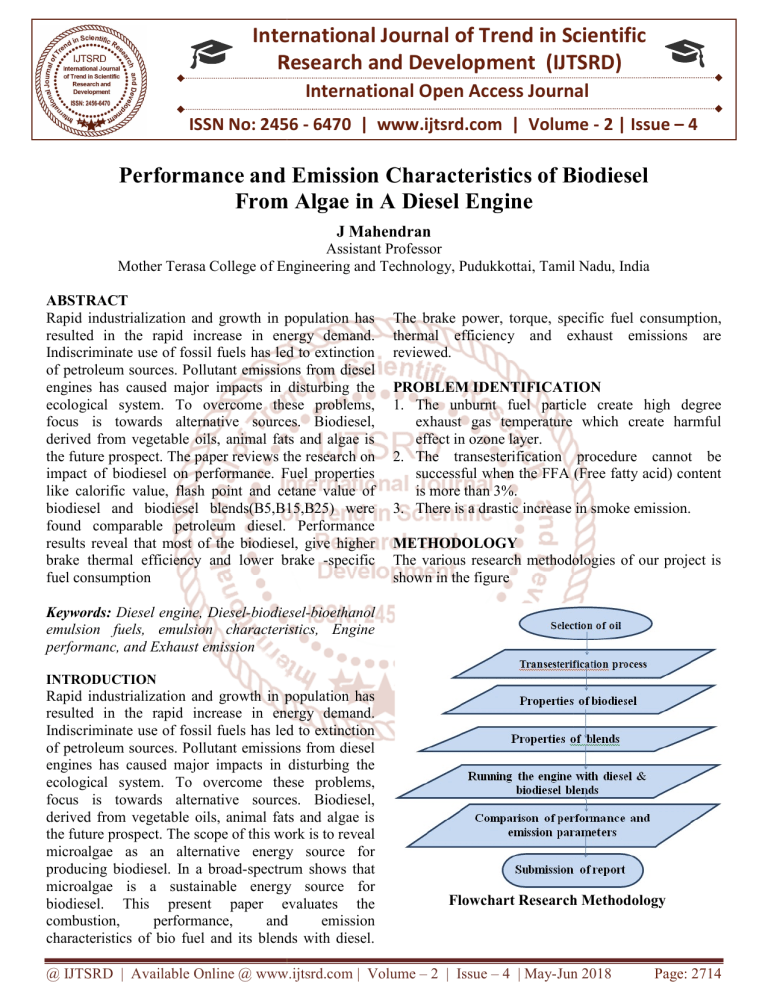
International Journal of Trend in Scientific
Research and Development (IJTSRD)
International Open Access Journal
ISSN No: 2456 - 6470 | www.ijtsrd.com | Volume - 2 | Issue – 4
Performance and Emissi
Emission
on Characteristics of Biodiesel
From Algae in A Diesel Engine
J Mahendran
Assistant Professor
Mother Terasa College off Engineering and Technology, Pudukkottai,, Tamil Nadu, India
ABSTRACT
Rapid industrialization and growth in population has
resulted in the rapid increase in energy demand.
Indiscriminate use of fossil fuels has led to extinction
of petroleum sources. Pollutant emissions from diesel
engines has caused major impacts in disturbing the
ecological system. To overcome these problems,
focus is towards alternative sources. Biodiesel,
derived from vegetable oils, animal fats and algae is
the future prospect. The paper reviews the resea
research on
impact of biodiesel on performance. Fuel properties
like calorific value, flash point and cetane value of
biodiesel and biodiesel blends(B5,B15,B25) were
found comparable petroleum diesel. Performance
results reveal that most of the biodiesel, give higher
brake thermal efficiency and lower brake -specific
fuel consumption
The brake power, torque, specific fuel consumption,
c
thermal efficiency and exhaust emissions are
reviewed.
PROBLEM IDENTIFICATION
1. The unburnt fuel particle create high degree
exhaust gas temperature which create harmful
effect in ozone layer.
2. The transesterification procedure cannot be
successful when the FFA (Free fatty acid) content
is more than 3%.
3. There is a drastic increase in smoke emission.
METHODOLOGY
The various research methodologies of our project is
shown in the figure
Keywords: Diesel engine, Diesel-biodiesel
biodiesel-bioethanol
emulsion fuels, emulsion characteristics, Engine
performanc, and Exhaust emission
INTRODUCTION
Rapid industrialization and growth in population has
resulted in the rapid increase in energy demand.
Indiscriminate use of fossil fuels has led to extinction
of petroleum sources. Pollutant emissions from diesel
engines has caused major impacts in disturbing the
ecological system. Too overcome these problems,
focus is towards alternative sources. Biodiesel,
derived from vegetable oils, animal fats and algae is
the future prospect. The scope of this work is to reveal
microalgae as an alternative energy source for
producing biodiesel. In a broad-spectrum
spectrum shows that
microalgae is a sustainable energy source for
biodiesel. This present paper evaluates the
combustion,
performance,
and
emission
characteristics of bio fuel and its blends with diesel.
Flowchart Research Methodology
@ IJTSRD | Available Online @ www.ijtsrd.com | Volume – 2 | Issue – 4 | May-Jun
Jun 2018
Page: 2714
International Journal of Trend in Scientific Research and Development (IJTSRD) ISSN: 2456-6470
PROPERTIES OF FUELS
S.NO
1.
2.
3.
4.
5.
Table 4.1 Properties Of Fuels
DENSITY(ρ)
CALORIFIC
kg/m3
VALUE (kJ/kg)
860
43500
926
43120
870
42150
889
41837
895
41432
FUELS
DIESEL
ALGAE OIL
B5
B15
B25
Table 4.2 Flash And Fire Point
FUEL BLENDS
FLASH POINT ᵒC
DIESEL
62ᵒC
ALGAE OIL
74ᵒC
B5
58ᵒC
B15
68ᵒC
B25
76ᵒC
S.NO
1.
2.
3.
4.
5.
KINEMATIC
VISCOSITY in centistoke
3.56
3.4
4.12
5.5
6.61
FIRE POINT ᵒC
65ᵒC
76ᵒC
60ᵒC
70ᵒC
78ᵒC
Table 5.1 specifications of the engine
Specification of the test engine type
Vertical, water cooled, four stroke
Number of cylinder
One
Bore
87.5mm
Stroke
110mm
Compression ratio
16.7:1
Maximum power
3.7kW
Speed
1500rpm
Dynamometer
Eddy current dynamometer
Injection timing
23ᵒ before TDC
Injector opening pressure
200kg/cm2
PERFORMANCE CHARACTERISTICS FOR DIESEL
S.No
1.
2.
3.
4.
Load
(kg)
0
2
4
6
Table 6.1 Performance Characteristics Of Diesel
Time taken
BP
BMEP
TFC
SFC
for 10cc of
(kW)
(bar)
(kg/h)
(kg/kW-h)
fuel (sec)
93.42
0
0
0.327
0
74.91
2
1.13
0.408
0.480
58.5
4
2.295
0.523
0.379
50.6
6
3.34
0.604
0.292
Bte (%)
0
14
22
29
1.
2.
0
2
Table 6.2 Performance Characteristics Of B5
Time taken
BP
FP
TFC
SFC (kg/kWfor 10cc of
(kW)
(kW)
(kg/h)
h)
fuel (sec)
67.5
0
2
0.457
0
58.5
2
2
0.529
0.2645
3.
4.
4
6
54.5
46.5
S.No
Load
(kg)
4
6
2
2
0.568
0.665
0.142
0.110
@ IJTSRD | Available Online @ www.ijtsrd.com | Volume – 2 | Issue – 4 | May-Jun 2018
Bte (%)
0
32.23
60.14
77.06
Page: 2715
International Journal of Trend in Scientific Research and Development (IJTSRD) ISSN: 2456-6470
The table 6.3 shows that performance characteristics of B15 fuel. The fuel B15 contain 15% of bio-fuel and
85% of diesel. The B15 is give the higher thermal efficiency compare with other bio-diesel. But less thermal
efficiency to the diesel.
Table 6.3 Performance Characteristics Of B15
S.No
Load
Time taken
BP
FP
TFC
BSFC (kg/kW- Bte (%)
(kg)
for 10cc of
(kW)
(kW)
(kg/h)
h)
fuel (sec)
1.
0
68.5
0
1.8
0.452
0
0
2.
2
58
2
1.8
0.533
0.267
32.31
3.
4
53
4
1.8
0.584
0.146
61.9
4.
6
47
6
1.8
0.6587
0.109
78.38
0
2
4
6
Table 6.4 Performance Characteristics Of B25
Time taken
BP
FP
TFC
BSFC (kg/kWfor 10cc of
(kW)
(kW)
(kg/h)
h)
fuel (sec)
76
0
1.6
0.407
0
62.5
2
1.6
0.487
0.256
55.5
4
1.6
0.557
0.134
48.5
6
1.6
0.638
0.11
S.No
1.
2.
3.
4.
Load
(kg)
Bte (%)
0
33.2
62.63
79.96
The table 6.4 shows that performance characteristics of B25 fuel. The fuel B25 contain 25% of bio-fuel and
75% of diesel. The B25 is give the higher thermal efficiency compare with other bio-diesel. But less thermal
efficiency to the diesel.
6.1.5 BRAKE THERMAL EFFICIENCY (BTE)
Figure 6.1 Comparison Of Brake Thermal Efficiency
The figure 6.1 is show the thermal efficiency of fuels. Brake power is taken in x-axis and thermal efficiency
should be taken in y-axis. the thermal efficiency of the blends has been compared with diesel fuel at various
loads and it is shown in figure 6.1. It is observed that the thermal efficiency for B25 is higher than all blends
and also with diesel.
SPECIFIC FUEL CONSUMPTION
In the graph, brake power is taken in x-axis and is taken Specific Fuel Consumption(SFC) in y-axis. The SFC
of the blends ha sbeen compared with diesel fuel at varios loads and it is shown in figure 6.2. it is observed that
the SFC is same as the bio-fuels for the entire range of load.
@ IJTSRD | Available Online @ www.ijtsrd.com | Volume – 2 | Issue – 4 | May-Jun 2018
Page: 2716
International Journal of Trend in Scientific Research and Development (IJTSRD) ISSN: 2456-6470
Figure 6.2 Comparison Of SFC
S.
no
1
2
3
4
Load
(amps)
0
2
4
6
Voltage Speed( Time
CO
HC
CO2
(V)
rpm)
(sec)
(%)
(ppm)
(%)
230
1500
55
0.03
11
0.80
230
1500
54
0.03
10
0.70
230
1500
49.5
0.02
9
0.90
230
1500
47.5
0.02
10
1.10
Table 6.5 Emission Characteristics Of Diesel
EMISSION CHARACTERISTICS OF DIESEL
Table 6.6 Emission Characteristics Of B5
S.no
Load
Voltage
Speed
Time
CO
HC
(Amps)
(V)
(rpm)
(sec)
(%)
(ppm)
1
2
3
4
S.no
1
2
3
4
S.no
1
2
3
4
0
2
4
6
230
230
230
230
1500
1500
1500
1500
67.5
58.5
54.5
46.5
0.01
0.01
0.03
0.03
6
1
8
64
O2
(%)
19.93
19.84
19.70
19.36
CO2
(%)
NOX
(ppm)
12
20
24
32
O2
(%)
NOX
(ppm)
0.10
0.30
1.30
1.8
20.74
20.55
19.42
18.43
3
8
19
68
Load
(Amps)
0
2
4
6
Table 6.7 Emission Characteristics Of B15
Voltage
Speed
Time
CO
HC
(V)
(rpm)
(sec)
(%)
(ppm)
230
1500
68.5
0.04
20
230
1500
58
0.02
16
230
1500
53
0.02
10
230
1500
47
0.02
9
CO2
(%)
0.90
1..10
1.30
1.50
O2
(%)
19.63
19.15
19.06
18.72
NOX
(ppm)
15
34
40
60
Load
(Amps)
0
2
4
6
Table 6.8 Emission Characteristics Of B25
Voltage
Speed
Time
CO
HC
(V)
(rpm)
(sec)
(%)
(ppm)
230
1500
76
0.03
10
230
1500
63.5
0.03
10
230
1500
55.5
0.02
7
230
1500
48.5
0.03
11
CO2
(%)
0.70
1
1
1.40
O2
(%)
20
19.50
19.50
18.93
NOX
(ppm)
14
28
37
59
@ IJTSRD | Available Online @ www.ijtsrd.com | Volume – 2 | Issue – 4 | May-Jun 2018
Page: 2717
International Journal of Trend in Scientific Research and Development (IJTSRD) ISSN: 2456-6470
Figure 6.4 Comparison Of Co2
This is mainly due to improper combustion of fuel efficiency. CO 2 Emission is increase in the blends in the
blends of B5 and B15. The CO2 emission of B25 nearer to diesel.
UNBURNED HYDROCARBONS
The unburned hydrocarbon emission of blends of Algae oil is more compared to that for neat diesel for all
loads. This is because of poor mixture formation tendency of blends of Algae oil as shown in figure 6.5.
Figure 6.5 comparison of HC
In addition to the other factors, the lower thermal efficiency wth these blends also is responsible for this trend.
It may be noted that a lower thermal efficiency with these blends will lead to injection of higher quantities for
the same load condition.
OXIDES OF NITROGEN
Figure 6.6 indicates that blends of Algae oil shows lower NOx emission compared to neat diesel fuel. This is
due to atomization of algae oil leads to poor combustion and lead lower NO x emission. Compare all the blend
B25 is emitted lower NOx emission.
Figure 6.6 Comparison Of Nox
@ IJTSRD | Available Online @ www.ijtsrd.com | Volume – 2 | Issue – 4 | May-Jun 2018
Page: 2718
International Journal of Trend in Scientific Research and Development (IJTSRD) ISSN: 2456-6470
CONCLUSION
When compared to all the blends of the bio-diesel has
high efficiency and in the mean while the specific fuel
consumption was to be lower than the various blends
with the diesel. The carbon monoxide emission is
higher than that of diesel blends. This is due to higher
viscosity and poor atomization tendency of algae oil
leads to poor combustion and higher carbon monoxide
emission. The unburned hydrocarbon emission of
blends of algae oil is more compared to that for neat
diesel for all loads. This is because of poor mixture
formation tendency of blends of algae oi. When
compared to the neat diesel blend B25 is emitted 41%
lower NOx emission. The specific fuel consumption is
increased in the case of Algae Oil-Diesel blends
compared to neat diesel. The unburned hydrocarbon
and carbon monooxide emissions are increased with
blends of Algae oil-Diesel as compared to neat diesel.
The smoke density also increase for the blends of
Algae oil-diesel compared to neat diesel. The oxides
of nitrogen (NOx) diesel. The exhaust gas temperature
decrease with the bleds Algae oil compared to neat
diesel. In general the performance and emission level
of algae diesel blends does not improve, but it can be
used as a low cost alternative fuel for diesel engine.
FUTURE WORK
The future scope is about to be a certain amount of
ethanol will be added to the existing one to increase
the properties of bio diesel nearer to the neat be CO
and CO2. Hence th eengine performance is also been
increased. Emission test shows reduction in NOx and
smoke in exhaust gases for Algae oil with respect to
conventional fuels at medium and higher power
output.
REFERNCES
1. Ahmad, Demirbas.A(2007),“ Importance Of
Biodiesel As Transportation Fuel”. Energy Policy,
35, 4661-70.
2. Avinash Kumar Agarwal, Chen.H, Geng.L.M,
Bian.Y(2010), “Experimental Studies On The
Combustion Characteristics And Performance Of
A Direct Injection Engine Fuelled With Biodiesel
Blends”. Energy Conversion And Management,
51, 2985-2992.
3. Balachanda.R.K, Costa, Lima.J.R, Ggrilo,
Bezerrafilho.B
(2008),“Exhaust
Emissions
Characteristics: An Experimental Study On Diesel
Engine Operated With Mixtures Of Diesel And
Natural Gas”. Brazilian journal of petroleum and
gas. V. 2, n. 1, p. 36-44.
4. Banapurmatha N.R,Bradley D. Wahlen, Robert M.
Willis, Lance C.(2011),“Biodiesel production by
simultaneous extraction and conversion of total
lipids from microalgae, cyanobacteria, and wild
mixed-cultures” Volume 102, Issue 3, Pages
2724–2730.
5. Colla,Tariq, Saqib Ali, Fiaz Ahmad, Mushtaq
Ahmad (2011),“Identification, FT-IR, NMR (1H
and 13C) and GC/MS studies of fatty acid methyl
esters in biodiesel from rocket seed oil”Volume
92, Issue 3, Pages 336–341.
6. Costa, Agarwal A K(2007),“Biofuels (alcohols
and biodiesel) applications as fuels for internal
combustion engines”, Progress in Energy and
Combustion Science, no. 3, 233–271, DOI
10.1016/j.pecs.2006.08.003.
7. Demirbas , Grau B, Bernat E, Antoni R, JordiRoger R, Rita P (2011),“Small-scale production of
straight vegetable oil from rapeseed and its use as
biofuel in the Spanish territory”.
8. Donghui, Qi,PoitratE(1999),“The potential of
liquid
biofuels
In
France.
Renewable
Energy;16:1084–9.
9. Gami, Demirbas.A (2003),“Biodiesel fuels from
vegetable oils via catalytic and non-catalytic
supercritical alcohol transesterifications and other
methods:a survey. Energy Conversion and
Management;44:2093–109.
@ IJTSRD | Available Online @ www.ijtsrd.com | Volume – 2 | Issue – 4 | May-Jun 2018
Page: 2719




